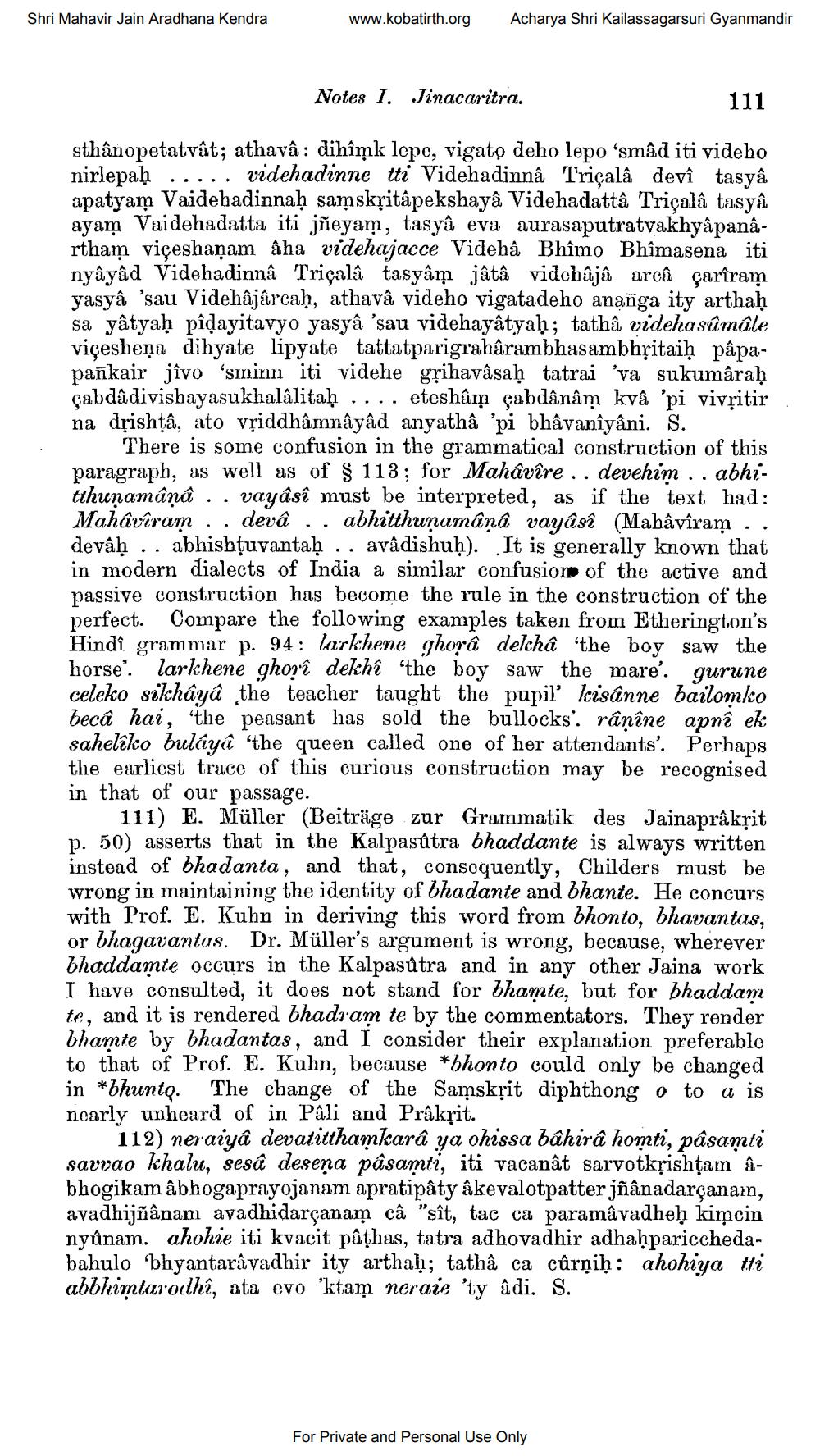________________
Shri Mahavir Jain Aradhana Kendra
www.kobatirth.org
ww
Acharya Shri Kailassagarsuri Gyanmandir
Notes 1. Jinacaritra.
111
sthânopetatvật; athavâ: dihîmk lope, vigato deho lepo 'smâd iti vide ho nirlepaḥ ..... videhadinne tti Videhadinnâ Triçalâ devî tasya apatyam Vaidehadinnaḥ samskritâpekshayâ Videhadattâ Triçalâ tasyâ ayam Vaidehadatta iti jñeyam, tasyâ eva aurasaputratvakhyâpanârtham viçeshanam âha videhajacce Videha Bhîmo Bhîmasena iti nyâyâd Videhadinnâ Triçala tasyam jâtâ vidchâjâ arcâ çarîram yasyâ 'sau Videhâjârcah, athavâ videho vigatadeho anañga ity arthaḥ sa yâtyaḥ pîdayitavyo yasyâ 'sau videhayâtyaḥ; tathâ videha súmâle viçesheņa dihyate lipyate tattatparigrahârambhasambhțitaiḥ pâpapañkair jîvo 'sminn iti videhe grihavâsah tatrai 'va sukumârah cabdâdivishayasukhalâlitaḥ .... eteshâm çabdânâm kvâ 'pi vivšitir na drishtâ, ato vřiddhâmnâyâd anyatha 'pi bhâvanîyâni. S.
There is some confusion in the grammatical construction of this paragraph, as well as of $ 113; for Mahâvîre .. devehim .. abhitthunamânâ . . vayâsî must be interpreted, as if the text had: Mahâvîram .. devâ . . abhitthuņamânâ vayâsî (Mahâvîram.. devâḥ . . abhishțuvantaḥ .. avâdishuḥ). It is generally known that in modern dialects of India a similar confusion of the active and passive construction has become the rule in the construction of the perfect. Compare the following examples taken from Etherington's Hindî grammar p. 94: larkhene ghorâ dekchâ the boy saw the horse'. larkhene ghorê dekhî 'the boy saw the mare'. gurune celeko sikhâyâ the teacher taught the pupil' kisanne bailomko becâ hai, the peasant has sold the bullocks'. rânîne apnê ek sahelêko bulâyâ 'the queen called one of her attendants'. Perhaps the earliest trace of this curious construction may be recognised in that of our passage.
111) E. Müller (Beiträge zur Grammatik des Jainaprâkrit p. 50) asserts that in the Kalpasútra bhaddante is always written instead of bhadanta, and that, consequently, Childers must be wrong in maintaining the identity of bhadante and bhante. He concurs with Prof. E. Kuhn in deriving this word from bhonto, bhavantas, or bhagavantas. Dr. Müller's argument is wrong, because, wherever bhaddamte occurs in the Kalpasůtra and in any other Jaina work I have consulted, it does not stand for bhamte, but for bhaddam te, and it is rendered bhadram te by the commentators. They render bhamte by bhadantas, and I consider their explanation preferable to that of Prof. E. Kuhn, because *bhonto could only be changed in *bhunto. The change of the Samskrit diphthong o to a is nearly unheard of in Pâli and Prakrit.
112) neraiyâ devatitthamkarâ ya ohissa bâhirâ homti, pâsamti sarvao khalu, sesa desena pâsamti, iti vacanât sarvotkrishtam âbhogikam âbhogaprayojanam apratipâty âkevalotpatterjñânadarçanamn, avadhijñânami avadhidarcanam câ "sît, tac ca paramâyadheh nyûnam. ahohie iti kvacit pâţhas, tatra adhovadhir adhahparicchedabahulo 'bhyantarâvadhir ity arthalı; tathâ ca cûrņih: ahohiya tti abbhimtarodhi, ata evo 'ktam neraie 'ty âdi. S.
For Private and Personal Use Only




